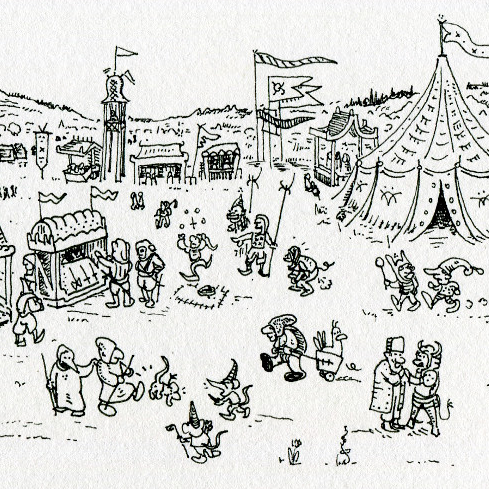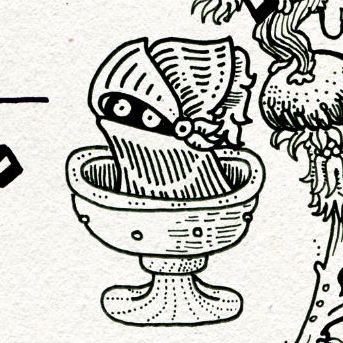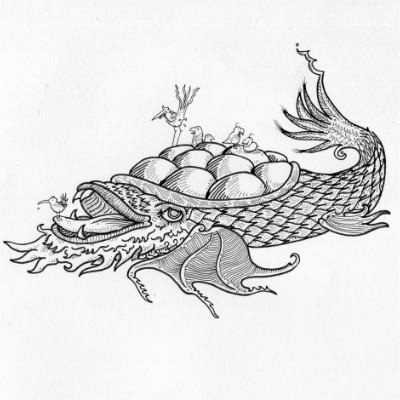
“Don’t touch them if they’re smelly!”
A SHORT INTRODUCTION TO KNEUTJES
Illustrated for your viewing pleasure.
Kneutjes
KNEUTJES ARE TINY HUMANOIDS that posses an amusingly low intelligence. It’s a popular saying that they can be outsmarted by a fruit fly. They are considered vermin, displaying behavior more akin to that of cockroaches or silverfish than anything else. Whatever they attempt to do usually turns into a mess and their inquisitive behaviour often gets them in trouble.
They mostly dwell in quiet, shaded places: ruins, forest undergrowth, abandoned & overgrown fields… wild places with little civilization and -more importantly- fewer predators. Because Kneutjes have natural enemies a-plenty: snakes, cats, birds, carnivorous plants and large insects. Anything with an appetite that isn’t itself a Kneutje will gladly pounce on these poor little things, if their own stupidity doesn’t kill them first.
- fig 1.A – A typical specimen, roughly 2 thumbs high. The gnats are attracted to its musky odor. Their meat is of a spongy texture, mostly tasteless but has a rich sweet-and-sour aftertaste.
Parasites
- fig 1.B – ‘Bermprinske‘. Kneutjes are susceptible to a wide range of parasites, including fleas & mistletoe. The small crown-like growths that sometimes protrude from their heads have given these types the nickname ‘Bermprinskes’. This particular Kneutje will enjoy a slight increase to its cognitive abilities before he gets bogged down by other, more vicious, parasites.
- fig 1.C – A heavily infested specimen. Small flowers have started to bloom from its barky skin, and a Moestiek has taken up residence in its hollowed-out body. The Kneutje does not actually suffer any physical pain from its infestations but may express signs of confusion and listlessness.
Procreation
- *fig 1.D* – Specimen with secondary-head growth. This is 1 possible scenario for a Kneutje to procreate. The growth will increase in size until it breaks free and heads off on its own.
- It has never been determined what procreation exactly entails for these quaint little creatures. Eyewitness reports present us with a wide variety of possible answers. Kneutjes have been known to ‘just appear’ by the dozens in a few hours’ time. In similar fashion they may appear alone or by 2 inside food: eggs, apples, pumpkins and cheese have all been known to reveal a Kneutje nestled inside.
Death
- Kneutjes regularly end up dead for many reasons, often due to their own clumsiness and curiosity. They decompose very rapidly and where they die the soil turns very fertile. On the location of their tiny corpse a small outburst of flowers and weeds often sprouts.
- fig 2.A – ‘Kneutteknolle‘, a root flower that typically sprouts on Kneutjes’ corpses. The taste resembles licorice.
Variant Strains
- fig 2.B – Gruttekneut was a humongous Kneutje that emerged from the vast Saksse forests. It was the attraction of the summer for the local hilltribes, people would come from far and wide to see this giant oaf stumble about. Gruttekneut survived for nearly 3 months before stubbing his toe on a house & tumbling to his death on a gentle slope.
THE KNEUTJES FOUND in cities & sewers seem to be a more social species; they build nests resembling disfunctional, messy beehives in which they stockpile all manner of shiny baubles & litter. This in an attempt to copy the behavior of the big folk around them. Children often like to break up and rummage through these nests to look for toys and valuables, to the dismay of the Kneutjes.
KNUDDES ARE HARDIER, more feral specimens that are known to exist on the isles off the coast of Pýktte. How they ended up on these desolate locations is up for debate. Presumably they ended up there by holding on to floating debris, or as accidental stowaways on ships. Every year they multiply at a preposterous rate on the tidal island of Dogge*, only to be swept away each spring by the rising tides.
Tidbits
- Kneutjes can turn out to be very enthousiastic procreators, and become too many, if left unchecked. A Kneuttecooyer is a professional exterminator who lures Kneutjes to their doom by using a captured Kneuttekooningxke* as bait.
- To commit a ‘Kneutte‘ means to commit an idiotic action. Similarly, to refer to someone as a Kneutte is a kind way to call someone an imbecile.
- Several Kneutjes can be spotted in the illustration of Hoogryk.
Notes
Kneutje — Lumpy, Cloddy.
From Dutch: ‘knot’, which is a ball of string or hair, a lump or clod.
Bermprinske — Roadside Princeling.
From Dutch: ‘berm’ (roadside, wayside) and ‘prins’, ‘prinsje’ (little prince).
Gruttekneut — Great-Kneut.
From Dutch: ‘groot’ (large, tall) and ‘knot’ (lump, clod).
Saksse — A land of dense forests and rugged mountain regions, located to the East.
Pýktte — A lush uninhabited island with several lumber camps on its coast. The local winters are often too harsh to sustain permanent settlements, as opposed to Dogge which only surfaces during winter.
Dogge — A vast tidal island, Dogge, barely reaches a few meters above sea-level. It is mostly uninhabited, save for a few seasonal fishing settlements. Nowhere in all of Bos are the shoals of fish so numerous and varied. Dogge lies under the sea level for the better part of each year, only surfacing during the winter months. It can be found in the top-right corner of this map.
Kneuttecooyer — A professional exterminator of pests, specializing in Kneutjes.
From Dutch: ‘knot’ and ‘kooi’ (cage).
Kneuttekooningxke — A particularly musky, old of Kneutje. The mold that covers them resembles a beard, and along with their crown-growth gives them the appearance of a tiny, destitute king.
From Dutch: ‘knot’ and ‘koning’, ‘koningske’ (king, little king).







